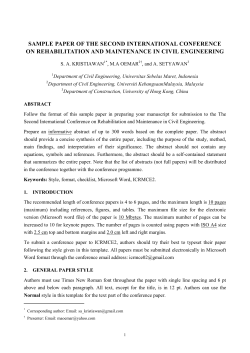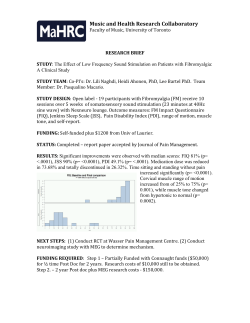
EE5725 Spring 2010 Homework Set 2 Solutions EE5725 HW1
EE5725 HW1 SOLUTION
EE5725 Spring 2010 Homework Set 2 Solutions
Problem 1
For a given component: h(t) = λ
where t is the operating time in hours, and λ = 0.005 (hr)―1
1) What is the mean time to failure MTTF of such a component?
MTTF = 1/λ = 1/0.005 = 200 (hours)
2) Given a population of 1000 such components operating independently, what is the
expected number of them still operating after 100 hours.
Consider the probability of surviving to t time
R(t) = 1 ― Q(t) = Ns(t) / N0
Hence, Ns(t) = R(t) N0 .
Also, λ(t) =
1
1 dR(t )
F (t ) = −
i
.
R(t )
R (t ) dt
Let R(t) = x(t), it is shown that
λ(t) = −
1 dx(t )
dx(t )
i
, and hence,
= − ∫ λ (t )dt ;
x(t ) dt
x(t )
100
100
ln x(t) = − ∫0 λ (t )dt = − ∫0 0.005dt = −0.5 , x(t) = R(t) = exp(-0.5) = 0.6065.
Therefore, Ns(t) = R(t) N0 = 0.6065*1000 = 606.5 ≈ 606. (Remove the uncertain point
in the rear); It is estimated that at t = 100 hours, 606 units (that had started operating at
0 hours) are expected to survive.
Problem 2
A utility company has a transmission line which goes over a mountain and is exposed
to many storms, wind, etc. and is rather unreliable. This line has a capacity of 500 MW.
They wish to add an additional 500 MW capacity to this interconnection. Two plans
have been submitted for increasing the capacity of the interconnection:
Plan A) Add a second 500 MW capacity circuit to the line over the mountain. We
shall assume that the failure and repair rates for the second circuit are the same as for
the first.
1
The failure and repair statistics are:
λa = 1/1000, μa = 1/200
We shall assume that the failure and repair rates for line b are identical. We shall
assume that in any state (Plan A has four possible failure states) that the transition from
a state is either due to a failure or a repair of one single component. Further, the λij for a
state transition will be the value of λ for that component which failed, similarly for μ’s.
Plan B) Requires building a double circuit line, each circuit having 250 MW
capacity through a longer route around the mountain. The circuits are treated as
independent with respect to failure rates and repair rates. The circuit for plan B is as
follows:
The capacity and the failure and repair rate for line a will be the same as in plan A. The
failure and repair rate for line c are:
λc = 1/8000, μa = 1/1000
The failure and repair rates for line d are the same as line c. Plan B has 9 states and the
λij and μij are equal to the λ and μ for the component which failed or was repaired
respectively.
The utility company is very concerned that the capacity of the transmission
interconnection be equal to or greater than 500 MW if they are going to add the
capacity to the system.
FIND:
For each plan, find the probability of having 500 MW or more capacity.
Note: This will require you to find the probability of being in one or more states whose
capacity meets the 500 or more MW criteria. To do so, find the probability of each
possible “operate/failed” state for the interconnection, and then label those that meet
the criteria and add the probabilities. (that is, the criteria is met if we are in state1 OR
state2 OR state3 OR ... each meeting the criteria).
Sol:
For Plan A:
λa = λb = 1/1000, μa = μb = 1/200
The status table of transition is depicted as follows:
A
1
1
0
0
Table I. Status table of Plan A
B
power
1
1000
0
500
1
500
0
0
2
status
operate
operate
operate
fail
Let {pi} be the probability of being in State i (i = 1, 2, 3, 4)
p1=
μ a μb
λa μb
μa λb
μa λb
, p2=
, p3=
, p4 =
;
( μa + λa )( μb + λb )
( μa + λa )( μb + λb )
( μa + λa )( μb + λb )
( μa + λa )( μb + λb )
Taking λa = λb = 1/1000, μa = μb = 1/200 into account, it is easy to find
p1 =
25
5
5
1
, p2 =
, p3 = , p4 =
36
36
36
36
The operating Probability = p1 + p2 + p3 =
35
= 0.9722, which indicates the probability
36
of transmission capacity being equal to as greater than 500MW.
For Plan B:
λa = 1/1000, λc = 1/8000, λd = 1/8000 ;
μa = 1/200, μc = 1/100, μd = 1/100 .
A
1
1
0
0
0
0
1
1
Table II. Status table of Plan B
C
D
power
1
1
1000
1
0
750
1
0
250
1
1
500
0
1
250
0
0
0
0
0
500
0
1
750
status
operate
operate
fail
operate
fail
fail
operate
operate
Construct the 8*8 status matrix as follows:
λd
0
0
0
0
0
λc
⎡1− (λc + λd )
⎤
⎢
⎥
μd
1− (λa + μd )
λa
0
0
0
0
0
⎢
⎥
⎢
⎥
0
μa
1− (μa + μd )
μd
0
0
0
0
⎢
⎥
0
0
λd
1− (λc + λd )
λc
0
0
0
⎢
⎥
P=
⎢
⎥
0
0
0
μc
1− (λd + μc )
λd
0
0
⎢
⎥
0
0
0
0
μd
1− (μa + μd )
μa
0
⎢
⎥
⎢
⎥
0
0
0
0
0
λa
1− (λa + μd )
μd
⎢
⎥
0
0
0
0
0
0
1− (μc + λd )⎦⎥
λd
⎣⎢
3
Do the MATLAB Program as below:
% Plan B_Program for State Probability Calculation
% Failure rates
lam_a=1/1000;
lam_c=1/8000;
lam_d=1/8000;
% Repair rates
mu_a=1/200;
mu_c=1/100;
mu_d=1/100;
% Transition Matrix
P=[1-(lam_c+lam_d) lam_d 0 0 0 0 0 lam_c; mu_d 1-(lam_a+mu_d) lam_a
0 0 0 0 0; 0 mu_a 1-(mu_a+mu_d) mu_d 0 0 0 0; 0 0 lam_d 1(lam_c+lam_d) lam_c 0 0 0; 0 0 0 mu_c 1-(lam_d+mu_c) lam_d 0 0; 0 0
0 0 mu_d 1-(mu_d+mu_a) mu_a 0; 0 0 0 0 0 lam_a 1-(lam_a+mu_d) mu_d;
mu_c 0 0 0 0 0 lam_d 1-(mu_c+lam_d)]
I=eye(8);
A=P-I;
Trans_A=transpose(A);
prob_matrix=[1 0 0 0 0 0 0 0]';
Trans_A(1,:)=1; % Replace the first row of Trans_A with 1
% State Probability Matrix
state_prob=inv(Trans_A)*prob_matrix
% Operating State (>=500MW)
P_operate =
state_prob(1)+state_prob(2)+state_prob(4)+state_prob(7)+state_prob(
8)
% Failed State (<500MW)
P_failed = state_prob(3)+state_prob(5)+state_prob(6)
4
>>P =
0.9998
0.0001
0
0
0
0
0
0.0001
0.0100
0.9890
0.0010
0
0
0
0
0
0
0.0050
0.9850
0.0100
0
0
0
0
0
0
0.0001
0.9998
0.0001
0
0
0
0
0
0
0.0100
0.9899
0.0001
0
0
0
0
0
0
0.0100
0.9850
0.0050
0
0
0
0
0
0
0.0010
0.9890
0.0100
0.0100
0
0
0
0
0
0.0001
0.9899
state_prob =
0.8129
0.0102
0.0020
0.1626
0.0020
0.0000
0.0001
0.0102
P_operate =
0.9959
P_failed =
0.0041
Verify that: P_operate + P_failed = 1.
Compare the Probability of operating, P_operate(B) = 0.9959 > P_operate(A) = 0.9722, it
clearly shows that Plan B offers an improved reliability over Plan A.
5
© Copyright 2025









![Neville v Lam (No 3) [2014] NSWSC 607](http://cdn1.abcdocz.com/store/data/001270068_1-1e7a197d8b7f552ca639af2a01cb4fd3-250x500.png)










